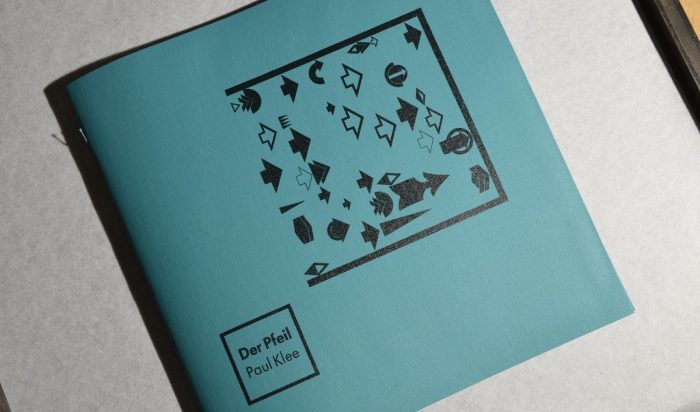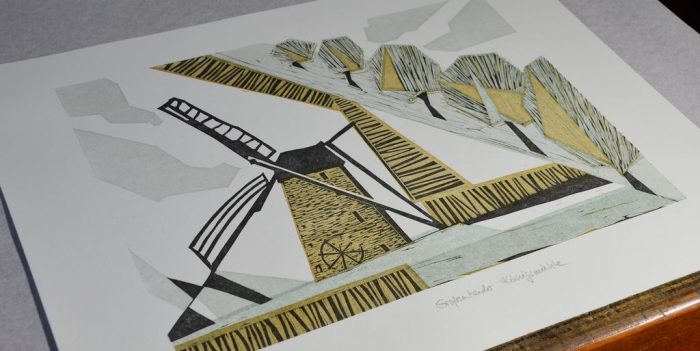Inseparable: Implementation and Content in the Artist‘s Book

There is a basic difference in the nature of the artist‘s book and the product of a publishing house.
The product of the publisher will present a text, there might be an introduction, a commentary, a preface, an epilogue.
The artist‘s book differs from that fundamentally. It is born from an idea. This is the seed from which the concept grows and develops. All which is part of the work, material, form, practicality, will melt into a complete works – a consistent entity. Content is core and starting point, the concept places it in its specific context.

The artist‘s book „Mir fehlt ein Wort“ (I am lacking a word) is paying homage to the great author and essayist Kurt Tucholsky, and it is immersed in the time in which he lived and wrote. This book is an example of how I work as an artist. What is characteristic of my works, my handwriting as an artist – if you come to think of it – is in their content and their concept, not necessarily in their visual appearance.

The artist‘s book consists of spoils throughout, meaning all sheets come with flaws. It present some 60 texts by Tucholsky. The sheets and snippets are bound in what is called the Prussian Archive Binding, a historic way of binding documents into a file to be stored for later use in an office or department of any authority. This binding resulted in portfolios where sheets could be taken out from for copying, and afterwards could be sewn back in again exactly where they had been taken out in the first place.

The cover is made from old board that was classically used for files. The sheets and snippets are marked, like if they had been officially checked, with stampings and glued in labels made of gummed paper in fading colours. The files sit in cardboard boxes, which are labelled with a number code, as if being part of an official archive. The centre of the story behind the work is, that a collection of treasured writings turns into a file for prosecution, once it falls into the hands of a power, that wants to get rid of the author in the first place.

In her book „The Century of Artist‘s Books“ Johanna Drucker writes „artist‘s books are almost always self-concious about the structure and meaning of the book as a form“. She lists criteria that she feels are characteristic of artist‘s books amongst them that they be „generally innovative in form“ or „concerned with explorations of books as an artistic concept“. According to Johanna Drucker „artist‘s books are creations rather than productions, visions rather than products, interrogations of its conceptual or formal or metaphysical potential.“
An artist‘s book is a work of art. It is not the product of a publishing house.
The artist‘s book „Fernöstliches Schmausbuch“ (Far Eastern Cookbook) is a typographic-philosophic recipe collection. Recipes from the Asian archipelago are combined with aphorisms and wise words about eating and drinking from that very region. All is printed on paper in the colours of spices such as cinnamon and ginger, both used frequently in the recipes chosen. Fabrics for the covers were chosen to go with the theme as well, in that they come in colours of spice, or with a design resembling blankets for elephants, or with peacocks, that are native to Asia.

Colours, practicality and visual appearance are all inseparably connected with and refering to the content of the work. This holds true also for the artist‘s book „MenschenWürdeRechte“, a collection of 16 articles of the Declaration of Human Rights.

From another point of view, the artist‘s book can be seen as form of art work, giving shape to one of the early ideals of the Bauhaus. In an artist‘s book pure art and craft become one. Art, as visualised content, connects with craft, which manufactures form and functioning.

The artistic mind contributes idea, concept, content and visual appearance, while the skill of the craftsman provides for the tangible: the form and function.
Seen this way book arts is the archetype of art in which the separation between pure art and craft does not exist.

The architect Walter Gropius saw the building as the ultimate result of man‘s creative endavour, in which art and craft flow into each other to become one. In this respect the artist‘s book is very similar to the building. The whole is more than the sum of its parts. What is obvious on the outside does not make the difference. The difference that rests inside creates the uniqueness.

The artist‘s book „Nichts bleibt wie es war“ (Nothing remains as it has been) also is an expression of its content. It pays homage to Lyonel Feininger (1871-1956) on his 150th anniversary., and to Henri Bergson (1859-1941) as well. Bergson‘s belief, that every moment we go through in life is burnt inextinguishably into our existence and thus changes us, is combined with the idea of cubism, which sets different stages in time or views from different directions of one object side by side. The whole work of art is made like if it was a collage, put together of little facettes.

This facetted character also shows in the illustrations, which are colour linocuts depicting windmills, while the crowns of the trees next to the mills feature the colours of all season at the same time. The windmill is taken as a symbol for change as such.

The artist‘s book is a work of art in its own right, exactly like the painting and the sculpture are works of art in their own right. It is created by an artistic mind, it is an interpretation of a theme or topic, of an experience or an encounter, and being a work of art it is the offer to the viewer to embark on the adventure of expanding their awareness and understanding. Artist‘s Statement – Annette C. Dißlin
For Reading
Johanna Drucker „The Century of Artists‘ Books“, Granary Books, 1995, New York, ISBN 1-887123-01-6
The works referred to:
To be continued on 7 June 2024


hello Annette, Lovely to see some of the Windmill prints
There are more to come soon!